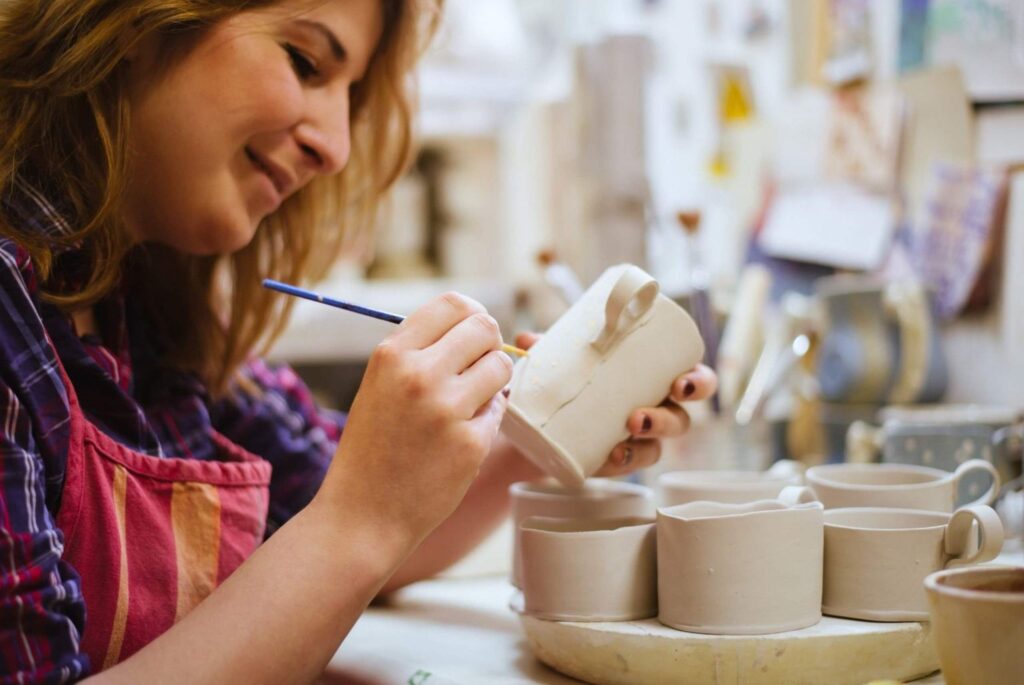In our fast-paced, digitally connected world, many people search for simple ways to slow down and find calm. Morocco’s rich artisan traditions offer an unexpected solution: mindfulness through craft. From zellige tilework to embroidery and weaving, these creative practices do more than preserve heritage they invite patience, focus, and peace of mind. Each craft connects hands, heart, and history, turning artistic creation into a form of quiet meditation that supports mental well-being.
The Meditative Art of Zellige Tilework
Zellige, the intricate mosaic tilework that decorates Moroccan palaces and riads, is a centuries-old art that demands concentration and presence. Artisans carefully hand-cut small, glazed tiles and arrange them into harmonious geometric patterns. This repetitive, precise process naturally encourages mindfulness — a flow state where time slows and worries fade.
For beginners, starting with small projects such as mosaic coasters or trays can offer the same calm satisfaction. The act of aligning each piece becomes a moving meditation, mirroring the patience and balance at the heart of Moroccan craftsmanship.
Berber Weaving: Mindfulness in Motion
High in the Atlas Mountains, Berber women have woven wool rugs for generations, creating patterns that carry deep cultural meaning. Each design is built with intention diamonds for protection, chevrons for mountains, and lines symbolizing life’s journey. The rhythm of weaving, from preparing the wool to guiding the shuttle, encourages steady breathing and presence.
At home, anyone can experience this same grounding practice by setting up a simple frame loom. As your hands repeat the motions, your mind becomes calmer, echoing the serenity of Morocco’s mountain villages.
The Calming Practice of Moroccan Embroidery
Moroccan embroidery transforms simple fabric into art through patience and repetition. Traditional motifs, such as pomegranates or flowers, are stitched using colorful threads that reflect Morocco’s joyful spirit. This accessible craft teaches focus and discipline each small movement of the needle builds into a beautiful whole. Many Moroccan women find comfort and connection through embroidery circles, where conversation flows as hands work.
Practicing embroidery at home can similarly relieve stress, bringing a sense of accomplishment and mindfulness through creative expression.
Why Moroccan Dates Are The Best Sweetener And How To Use Them
Dates have been part of Moroccan life for centuries, not only as a staple food but also as a symbol...
Invest in Senegal 2025: A Gateway for Moroccan Companies to Expand in Africa
On October 7–8, 2025, the Abdou Diouf International Conference Center (CICAD) in Diamniadio will host the second edition of Invest...
The Art of Letting Go: 10 Simple Ways to Live a Fun and Happy Life
Life has a funny way of getting heavy sometimes. We hold on to grudges, regrets, fears, and expectations as if...
How eating Moroccan salads before meals improves health
Morocco's culinary tradition of serving vibrant, flavorful salads as appetizers isn't just about tantalizing the taste buds—it's a time-honored practice...
Amina El Fassi shares her experience about how creative Moroccan traditions can help anyone cultivate mindfulness through tactile, meaningful activities, says Amina:
“I discovered Moroccan pottery during a stressful period in my life, every Thursday evening, I attend a workshop in the old medina where a local potter teaches traditional techniques. The moment my hands touch the cool clay, my racing thoughts slow down. Shaping tagines and decorating them with Fassi patterns has become my therapy. Our ancestors knew something profound, that working with your hands and honoring tradition can heal the mind.”

Leather Craft: Ancient Skill, Modern Calm
Morocco’s world-famous leatherwork, particularly from Fez, offers another form of mindful practice. Leather tooling pressing or carving designs into natural leather requires patience and precision. The repetition of tracing, cutting, and embossing engages the senses and quiets mental noise.
Whether crafting a bookmark or a journal cover, artisans experience the same grounding calm that has defined Moroccan craftsmanship for centuries. Each piece becomes a reflection of both artistry and inner stillness.
Calligraphy and Geometric Art: Drawing Stillness
Moroccan calligraphy and geometric art are deeply spiritual forms of expression. The sweeping Arabic letters and repeating star patterns that adorn mosques and manuscripts were traditionally created as acts of devotion. Learning to draw these geometric designs today can serve as a meditative practice; every circle, line, and angle demands focus and precision.
As your hand follows ancient mathematical patterns, your thoughts align with rhythm and harmony, embodying the essence of mindfulness through creation.
Conclusion
Moroccan crafts are more than cultural treasures, they are doorways to mindfulness in a modern world that often feels overwhelming. Whether you’re cutting tiles, weaving wool, stitching fabric, shaping clay, or sketching geometric patterns, each craft teaches patience, presence, and appreciation for slow creation.
These traditional practices remind us that peace doesn’t always come from stillness; sometimes, it’s found in the steady rhythm of our hands. By embracing Moroccan crafts as mindful hobbies, we connect with both our roots and ourselves, one intentional movement at a time.















Discussion about this post